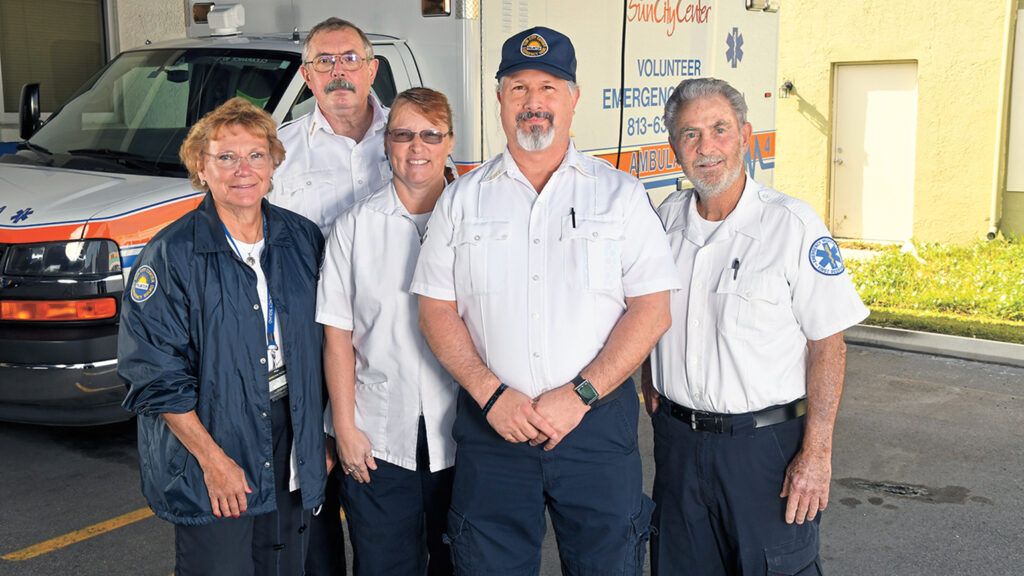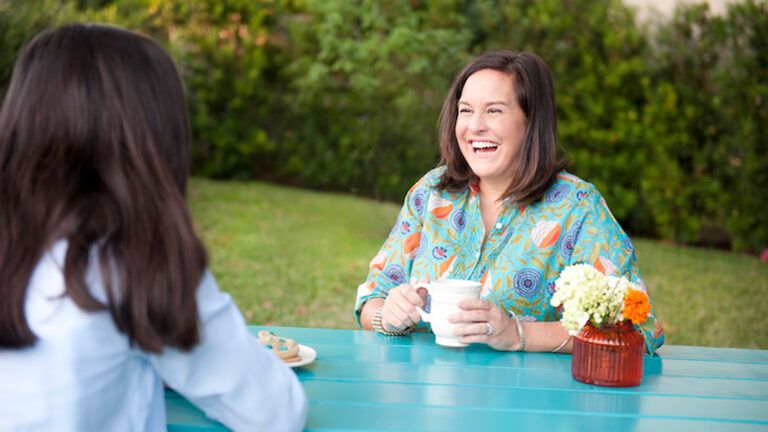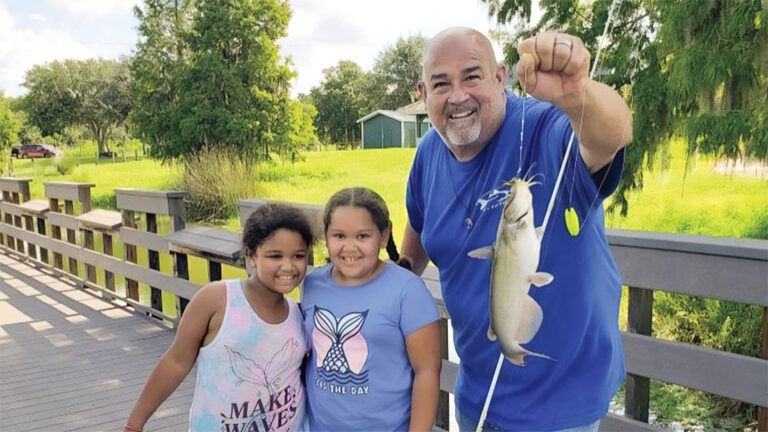Three emergency responders crouched beside an unmoving patient. He was older—not breathing. It was time to perform lifesaving CPR. Every second mattered. Ken Ayers straightened his elbows and pressed down. He counted out 30 chest compressions. Marilyn Navarro tilted the patient’s head back to attach a resuscitation mask. She delivered two rescue breaths. Lloyd Banfield kept his eye on the automated external defibrillator, or AED.
“You don’t want to push too hard or he’ll throw up,” said Lloyd.
And then it happened. I laughed. I couldn’t help it. We were all piled into a small office. It was the middle of a training exercise. I was squatting on a blue tumbling mat. Captain Robert Leonard stood beside the door. I peered down at the rubber dummy torso. He wouldn’t be losing his cookies anytime soon.
I was spending the day with the Sun City Center Emergency Squad, a volunteer organization that provides the Sun City Center, Florida, senior living community with basic life support services and ambulance transportation—as well as wheelchair, crutch and cane lending. Almost all the volunteers are seniors.
Robert motioned me over to the doorway. “Do you want to give it a try?”
I wouldn’t choose to administer CPR—even on a dummy. Medical procedures made me nervous. I had never performed any basic life support. I tried to brush it off.
Robert smiled, undeterred. “It’s good to get a feel for it.”
I nodded. There’s a first time for everything, I thought. I knew that most members of the squad didn’t have a medical background. They were retirees who trained to become emergency medical responders, emergency medical technicians and ambulance drivers. Or front desk receptionists. Or van drivers. Only 170 of the 420 volunteers worked as emergency responders. The rest were support staff. The oldest active squad member was 90 years old. One captain was 88. I was 28 and had both my original knees. Surely I could do this.
I knelt down on the mat. Ken showed me how to center the heel of my hand over the dummy’s chest. I put the other hand on top and pushed down. Hard. With most of my body weight.
“I feel like I’ll break his rib,” I said.
Ken nodded. “If you don’t do it that way, you might lose the patient.”
We walked to the Ready Room, the standby space decorated with patches from emergency responders all over the United States—hometowns of current and past squad members. Everyone has a past. A life before Florida.
We sat down at a round table. A TV buzzed in the background. The emergency phone line rang. Everyone stopped. It was a busy day in Sun City Center—six calls before eleven o’clock. Each of them passed through to a volunteer dispatcher and was broadcast over the loudspeaker. But this caller hung up. Wrong number.
Everyone relaxed.
“So,” I said, “what was your life like before joining the squad?”
Everyone looked at each other.
“I was in the Navy,” Lloyd began. “Then I was an engineer for Ford and a maintenance superintendent at a steel mill. I popped around a lot of different places.” He had lived in West Virginia, Virginia, Alabama, North Carolina and California. Lloyd came to Sun City Center on the advice of his daughter. She had spotted a golf cart in the drive-through line at Taco Bell and knew her dad would appreciate the attitude. Not to mention the weather.
Lloyd joined the squad without medical experience. But he had what you could call training. Of a sort. Lloyd leaned back in his chair. “My wife is a nurse. My oldest daughter is a nurse. My middle is a med tech. My sister is a nurse practitioner.” He joked that he became an EMT and ambulance driver to finally get a word in edgewise. “I worked in machinery most of my life. The body is nothing but a machine. You’ve got muscles, joints, a brain and a heart instead of pumps, computers and transmission lines. But it’s all there.”
“I was a combat medic,” said Ken. “That was short-lived. I’m an environmental engineer by training.” He started as an EMR; everyone does. These days he’s an EMT and driver. “I’m like Lloyd. I come from a medical family. We moved down here to be closer to our daughter. She’s a physician.”
Marilyn smiled. She said that she had always wanted to work in a medical field. “I was in nursing school.” But she decided to become an EMT after a mission trip to Haiti. A nurse couldn’t treat a little boy who fell off a dump truck because he was too badly injured. It disturbed Marilyn. She thought they could do more. “It upset me that I didn’t know anything.”
She flew back to Ohio, determined to get as much medical training as quickly as possible. But after becoming a certified EMT, Marilyn couldn’t find work. “This was in the early ’80s,” she said. “No one was hiring women EMTs in Ohio. I even did the advanced class.” She became a paralegal instead. Now she drives the ambulance and works as an EMR.
I asked the group if they could tell me about their last call. What had happened? Who was there?
“A woman ended up on the floor,” said Ken. “Lloyd checked her out to make sure there were no spinal injuries.” She couldn’t stand on her own. They got a stretcher. “She lived alone, and her Lifeline went off. Forty-two percent of our calls are fall-related.”
I thought, That’s working in a retirement community.
I moved to a conference room to talk with Deputy Chief Jim Ryan. He listed all the volunteer positions. There’s the driver, EMR, EMT. They ride in the ambulance. Then there’s front desk. The IT personnel. Van drivers. Cooks. (One even trained at Le Cordon Bleu.) The coordinator. Dispatcher. Captain. And assistant captain.
“There are eight teams total,” said Jim. Fifty-five members per team. Lots of couples. “We have 52 couples. Eight couples on one team.” Including Jim and his wife. “We would be lost without our couples.”
Across the hall was Marty Gifford, the squad’s chief financial officer. Jim leaned forward in his chair. “We’re no pay, no charge,” he said. “Marty always says the only things we don’t have are payroll and billing. We work for food.” Today it was sloppy joes and salad along with ambrosia.
The squad saves Hillsborough County two million dollars every year in emergency care. They keep the lights on with donations. Including one recent $255,000 bequest to pay for two ambulances.
If it’s one of five complaints—chest pain, difficulty breathing, possible stroke, seizure or possible suicide—the squad calls 911. But its members still take 12 to 24 calls a day. “It frees up the county to move on to the next person rather than waste 45 minutes at the hospital,” Jim said. “People like to call us because they know they won’t get a bill.”
I paused. “Tell me about life before Florida.” Jim straightened up, surprised.
Perhaps he’s only here to talk logistics, I thought.
But he softened. “We moved to Sun City Center after a bad winter in New Hampshire. We used to come here every year for my wife’s birthday.” To visit her sister. She had bought a house seven years before Jim and his wife retired. “It was always assumed that when I got here I would work for the squad.” Their kids were still shocked when he did. Jim had always been in computers. Worked for HP. “Other than putting on a Band- Aid,” he’d had no medical experience.
A lot of what sticks with him now are the conditions that seniors live in. “Sometimes we go into a home. Trash piled up. Animal droppings,” he said. Some people stay in their houses longer than they can take care of themselves. “I’ve been an EMT 12 years, and it never surprises me how people live.” When the squad finds a person who can’t care for themselves, they call 211. Crisis support. “It’s our magic number.”
I visited Margaret Whitford at the front desk. It was her first day on the job. She was chipper, with bright red hair. Originally from Fort Worth, Texas. She sat next to Skip Aylesworth. He was teaching her the ropes. How to check people in. Fill out forms. Answer the phone. “You have to do something three or four times before anything clicks,” she said. “But people are patient.”
“It must be nice to live here,” I said. “Everything you need is close by.”
“I’m used to a bigger city,” she said. “I’m spoiled rotten. My major complaint is that you gotta drive a half hour to get something good to eat around here.”
I asked her about volunteering.
“There are takers in this world, and there are givers.” Margaret had always volunteered. Fund-raising. Scholarship programs. Working with young people. “If you live in a community, you have to be a part of it. Sun City Center takes a village.”
“I’ll write that down,” I said. Sun City Center: Good community. Needs more restaurants.
Read More: 5 Benefits for Seniors Who Volunteer
For more inspiring stories, subscribe to Guideposts magazine.




